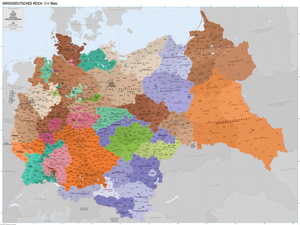
Back التقسيمات الإدارية في ألمانيا النازية Arabic Divisions administratives de l'Alemanya nazi Catalan Struktur der NSDAP German Divisiones administrativas de la Alemania nazi Spanish Divisions administratives du Troisième Reich French Divisións administrativas da Alemaña nazi Galician A Harmadik Birodalom közigazgatása Hungarian Divisioni amministrative della Germania nazista Italian 大管区 (ナチ党) Japanese 나치 독일의 행정 구역 Korean





The Gaue (singular: Gau) were the main administrative divisions of Nazi Germany from 1934 to 1945.
The Gaue were formed in 1926 as Nazi Party regional districts in Weimar Germany based on the territorial changes after the First World War.[1] The Gau system was established in 1934 as part of the Gleichschaltung process, replacing the de jure system of Länder (states) and Prussian provinces, which held no administrative purpose since the Enabling Act of 1933 and were reduced to rudimentary bodies. Each Gau was headed by an administrative leader, the Gauleiter, a high-ranking Nazi Party official with near-autocratic powers.
Germany consisted of 32 Gaue in 1934, eventually peaking at 42 Gaue with regions occupied in 1938 to early 1939 (Austria, Sudetenland, Memelland) and conquered during the Second World War incorporated into existing Gaue or organised as Reichsgaue, a special type of Gau where the Gauleiter also carried the position of Reichsstatthalter.[1][2] The Gaue system was dissolved on 8 May 1945, following the surrender of Nazi Germany.
- ^ a b (in German) Die NS-Gaue Archived 27 August 2014 at the Wayback Machine, Deutsches Historisches Museum, accessed: 25 June 2008
- ^ The Organization of the Nazi Party & State Archived 9 November 2016 at the Wayback Machine The Nizkor Project, accessed: 25 June 2008